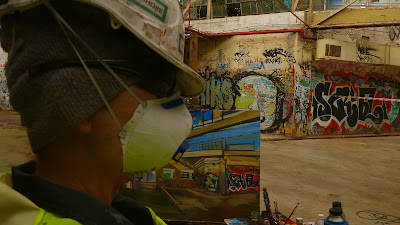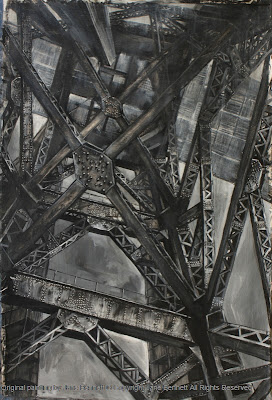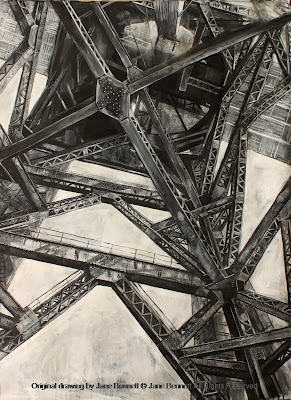 |
| 'Abandoned Dunlop-Slazenger factory Soda panorama' 2015 oil on canvas 91 x 183cm Enquiries |
The walls are rich in texture, vibrant in colour and elaborate in detail.
They are possibly full of hidden meanings, incomprehensible to the uninitiated, or it could be just random doodling.
 |
| 'Abandoned Dunlop-Slazenger factory Soda panorama' 2015 oil on canvas 91 x 183cm Enquiries |
 |
| 'Abandoned Dunlop - Slazenger factory - 'Soda' panorama' 2015 oil on canvas 91 x 183cm Enquiries |
Images are scattered throughout the factory, but the text dominates and has become imagery in its own right.
 |
| 'Abandoned Dunlop - Slazenger factory - 'Soda' panorama' 2015 oil on canvas 91 x 183cm Enquiries |
The letters are outlined in black, often with highlights of white or red on the ascenders (the parts of letters such as "h" "b" or "d" that extend above the line) or descenders (the parts of letters such as "g" "q" or "j" that extend below the line).
Occasionally backgrounds of gold or silver add a bit more bling and some are even adorned with star bursts.
 |
| 'Abandoned Dunlop - Slazenger factory - 'Soda' panorama' 2015 oil on canvas 91 x 183cm |
John Paul, the demolisher who had given me the heads up about the site, finally nailed it.
The Book of Kells, he said. (John Paul is Irish!)
To be sure, to be sure!
 |
| Detail of 'Abandoned Dunlop - Slazenger factory - 'Soda' panorama' 2015 oil on canvas 91 x 183cm Enquiries |
This is a close up of my painting of the graffiti on left hand wall, and you can see that John Paul really had a point.
In another context, I could easily imagine one of the letters as a historiated initial in a medieval illuminated manuscript.
A historiated initial is an enlarged letter at the beginning of a text, which contains a picture.
 |
| Detail of 'Abandoned Dunlop - Slazenger factory - 'Soda' panorama' 2015 oil on canvas 91 x 183cm Enquiries |
This is a closeup detail of my painting of the graffiti in one of the small rooms to the left hand side.
This font is dramatically serif (there is a large difference between thick and thin lines) and is extravagantly embellished with finials( tapered or curved ends), swashes (extended decorative flourishes)and lachrymals (teardrop shapes).
 |
| Detail of 'Abandoned Dunlop - Slazenger factory 'Soda' panorama' 2015 oil on canvas 91 x 183cm Enquiries |
"Soda" has been written in a more "slab serif" style, where there is less difference between thick and thin lines.
This tag stands out from its neighbours due to its cleaner font as well as its striking silver, black and pink colour scheme.
 |
| Detail of windows in 'Abandoned Dunlop - Slazenger factory - 'Soda' panorama' 2015 oil on canvas 91 x 183cm Enquiries |
These windows are very stained indeed.
The graffiti is probably much older than on the walls, as they would have only been accessible when the building still had a roof, which was at least a couple of years ago.
 | |
| 'Abandoned Dunlop - Slazenger factory - 'Soda' panorama' 2015 oil on canvas 91 x 183cm Enquiries At sunset the window colours are reflected on the ground in a series of rainbows, an effect I last experienced visiting Chartres cathedral. Related posts |





















